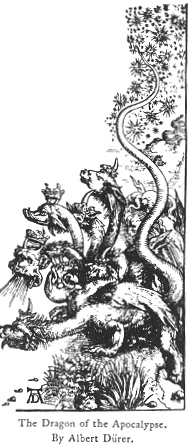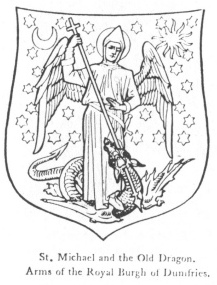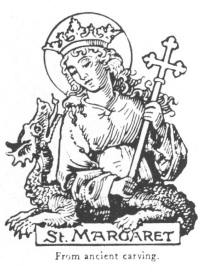
Masonic, Occult and Esoteric Online Library
Fictitious and Symbolic Creatures in Art
By John Vinycomb
Chimerical Creatures of the Dragon and Serpent kind - The Dragon in Christian Art
It was believed that in the gloomy land of the Cimmerians and the confines of Hades strange monsters were to be met; and not only there, but in any part of the universe which was conceived to be beyond the pale of human habitation these weird creatures might be encountered. The same idea is recognised in the Semitic belief, that uncanny beings lurked in the outer deserts, where men did not penetrate at all, or did so only at great danger. The "place of dragons" is associated with "the shadow of death" (Ps. xliv. 19). Dragons are also associated with the waters of the deep (Ps. lxxiv. 13) and are called upon to praise Jehovah (Ps. cxlviii. 7); and Isaiah (xxxiv.), describing in vivid and picturesque language the destruction and utter desolation which shall come on Zion's enemies, prophesies that her palaces and fortresses "shall be a habitation for dragons."
The term dragon is applied by the translators of the Scriptures to some monsters of which we have no knowledge. The word is used by ecclesiastics of the Middle Ages as the symbol of sin in general and paganism in particular, though ofttimes heresy is denoted. The metaphor is derived from Rev. xii. 9, where Satan is termed the Great Dragon; in Psalm xci. 13, it is said "the saints shall trample the dragon under their feet."
In the book of Job we recognise in Leviathan a creature more like the extinct saurians of the old world than any crocodile recorded in historic times; and this leviathan is treated as still existing in the days of David. In Psalm lxxiv. 13, 14, Jehovah is spoken of as having broken the heads of the dragons in the waters; in Isaiah li. 9, as having wounded the dragon; and pæans are sung on the punishment of "Leviathan, that crooked serpent," and the slaying of "the dragon that is in the sea" (Is. xxvii. 1). Finally, in the Apocalyptic 
vision, "there appeared another wonder in heaven; and behold a great red dragon, having seven heads, and ten horns, and seven crowns upon his heads, and his tail drew the third part of the stars of heaven, and did cast them to earth" (Rev. xii. 3, 4); "I saw an angel come down from heaven, having the key of the bottomless pit and a great chain in his hand, and he laid hold on the dragon, that old serpent, which is the Devil and Satan, and bound him" (Rev. xx. 1, 2).
As a Christian emblem the dragon may be taken to symbolise the supreme spirit of evil, a veritable devil whom it was the special mission of militant saints to slay, as it had been the glory of the heroes of the pagan mythology to conquer. "In pictures of sacred and legendary subjects," says a late writer, "the dragon usually formed an important feature. The evil thing was invariably depicted writhing under the foot of the saint, or transfixed with his triumphant spear. In like manner the virtues trampled tranquilly each on her complementary vice, embodied in the form of some impossible creature; and if the rigid virtues were sometimes insipid, it must be allowed that the demons were usually grotesquely characteristic, and often delightful in colour."
The prostrate attitude usually signifies the triumph of Christianity over Paganism, as in pictures of St. George and St. Sylvester; or over heresy and schism,

as when it was adopted as the emblem of the Knights of the Order of the Dragon, in Hungary, which was instituted for the purpose of contending against the adherents of John Huss and Jerome of Prague. The dragon in Christian Art is often very variously represented, sometimes as a serpent, at other times as a dragon or wyvern, or again in the symbolic figure partly human, under which form we find the "old serpent" (the Devil) often represented, as in the conflict of St. Michael the Archangel. The numerous legends of saints who have fought and overcome dragons prove the symbolic light in which the impersonation of evil was generally viewed.
St. Margaret is the patron 
saint of the borough of Lynn Regis, and on the old corporation seal she is represented standing on a dragon and wounding it with a cross. The Latin inscription on the seal is "Sub Margaret teritur draco stat cruce læta." The modern shield of the town is now blazoned: azure three conger's (or dragon's) heads erased and erect, the jaws of each pierced with a cross crosslet fitchée or. In paintings St. Margaret is represented as a young woman of great beauty hearing the martyr's palm and olive crown, or with the dragon chained and helpless at her feet as an attribute. Sometimes she is depicted coming from the dragon's mouth, for the legend says the monster swallowed her, but on her making the sign of the cross he was compelled to free her again. A legend states that Olybus, Governor of Antioch, captivated by the beauty of Margaret, wished to marry her; as she rejected him with scorn he threw her into a dungeon, where the devil appeared to her in the form of a horrible dragon and endeavoured to frighten her from her path. Margaret held up the cross and the dragon fled. Other legends say he burst asunder.
